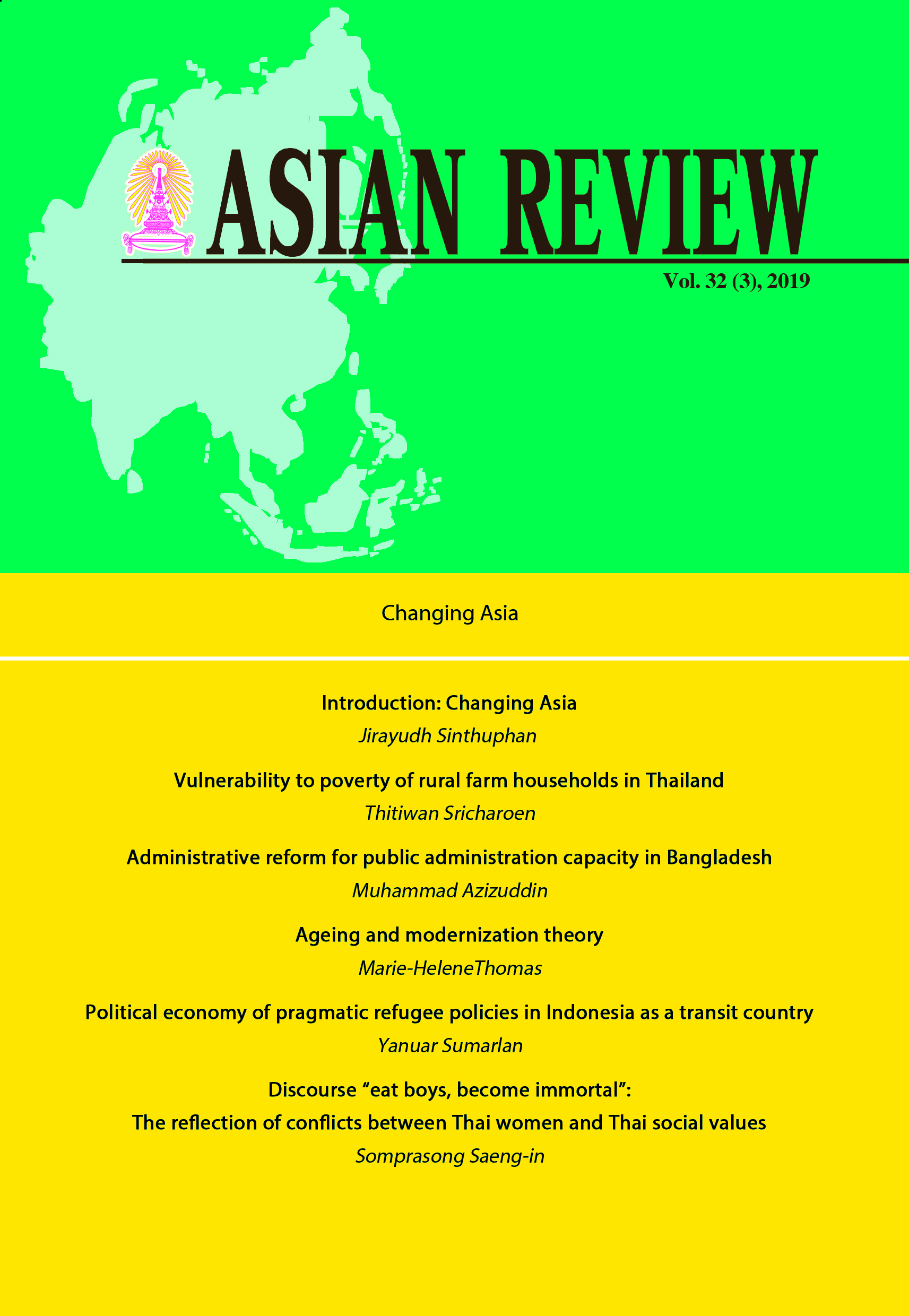Ageing and modernization theory
Keywords:
Ageing, modernity, modernization theory, ageism, elderly, filial pietyAbstract
Societies are moving towards a greying-nation at the fastest rate the world has ever seen with increasing numbers of centenarians each year. Current life-expectancy rates indicate that a person can expect to live 20 to 30 more years past the age of retirement. However, the modernization theory argues that the value of older people in society is decreasing with modernity and as a society moves away from tradition and towards a youth-oriented ideology, older people are left behind and deemed to be less important. Research is demonstrating that, with modernity, the concept of filial piety in Asian countries is declining, which results in an increase in older individuals living by themselves and feeling neglected as opposed to being respected or celebrated in old age.
References
Asian Pacific Centre. 2000. Comparative Research on Elderly Care in the AsiaPacific Region: Malaysia, China, Australia and Japan. Fukuoka: Japan.
Barak, Benny and Schiffman, Leon G. 1981. “Cognitive Age: A Non-chronological Age Variable.” In Advances in Consumer Research Volume 08, edited by Kent B. Monroe, Anna Abor, 602-606. MI: Association for Consumer Research.
Basaraba, Sharon. 2018. Chronological vs. Biological Age. Verywell health, https://www.verywellhealth.com/what-is-chronological-age-2223384
Biggs, Simon. 1993. Understanding Ageing: Images, Attitudes and Professional Practice. Buckingham: Open University Press.
Bond, John, Peter G. Coleman, and Sheila Peace. 1993. Ageing in Society: An Introduction to Social Gerontology. London: SAGE Publications.
Bond, John, Roger Briggs, and Peter G. Coleman. 1993. “The Study of Ageing.” Ageing in Society: An Introduction to Social Gerontology, edited by John Bond, Peter G. Coleman and Sheila Peace, 19-52. London: SAGE Publications.
Clammer, John. 1995. “Consuming Bodies: Constructing and Representing the Female Body in Contemporary Japanese Print Media.” In Women, Media and Consumption in Japan. edited by Lise Skov and Brian Moeran. 197-219. Surrey: Curzon Press.
Clark, M. 1967. “The Anthropology of Aging, a New Area for Studies of Culture and Personality.” The Gerontologist 7(1): 55-64.
de Magalhães, João Pedro. 2011. “The Biology of Ageing.” In An Introduction to Gerontology, edited by Ian Stuart-Hamilton, 21–47. Cambridge: Cambridge University Press. doi:10.1017/CBO9780511973697.002.
Donnellan, C. 1992. Ageing: Everyone’s Future. Cambridge: Independence.
Featherstone, M. and M. Hepworth. 1993. “Images of Ageing.” In Ageing in Society: An Introduction to Social Gerontology, edited by John Bond, Peter G. Coleman and Sheila Peace, 304-332. London: SAGE Publications.
Goodman, Roger and Harper, Sarah. 2008. “Introduction: Asia’s Position in the New Global Demography.” In Ageing in Asia, edited by Roger Goodman and Sarah Harper, 1-13. London: Routledge.
Hendricks, J. 2005. “Ageism: Looking Across the Margin in the New Millennium.” Generations: Journal of the American Society on Ageing 29(3): 5-7.
Hocky, Jenny and Allison James. 1993. Growing up and Growing Old. London: SAGE Publications.
Holmes, Ellen Rhoads and Lowell Don Holmes. 1995. Other Cultures, Elder Years. London: SAGE Publications.
Hurwicz, Margo-Lea. 1995. “Introduction: Anthropology, Aging, and Health.” Medical Anthropology Quarterly 9(2): 143-145.
Lebra, Takie Sugiyama. 1979. “The Dilemma and Strategies of Aging among Contemporary Japanese Women.” Ethnology 18(4): 337-353.
Miller, L. 2006. Beauty Up: Exploring Contemporary Japanese Body Aesthetics. London: University of California Press.
Schwaiger, Liz. 2006. “To Be Forever Young? Towards Reframing Corporal Subjectivity in Maturity.” International Journal of Ageing and Later Life 1(1): 11-41.
Stott, M. 1981. Ageing for Beginners. Oxford: Basil Blackwell.
Wada, S. 1995. “The Status and Image of the Elderly in Japan: Understanding the Paternalistic Ideology.” In Images of Aging: Cultural Representations of Later Life, edited by M. Featherstone and A.Wernick, 48-60. London: Routledge.
Woodward, K. 1991. Aging and Its Discontents. Bloomington: Indiana University Press.
Downloads
Published
How to Cite
Issue
Section
License
Published articles are under the copyright of the Instiute of Asian Studies, Chulalongkorn University. Partially or totally publication of an article elsewhere is possible only after the consent from the editors.







